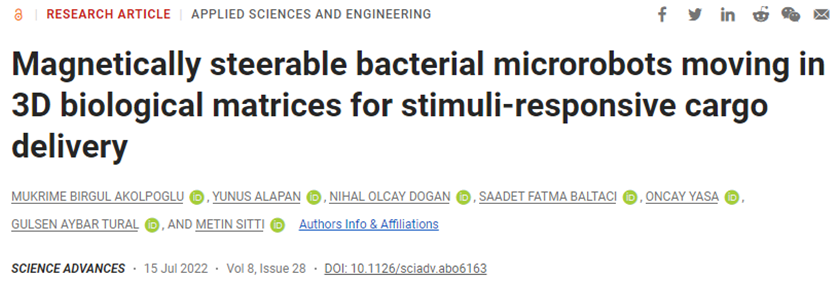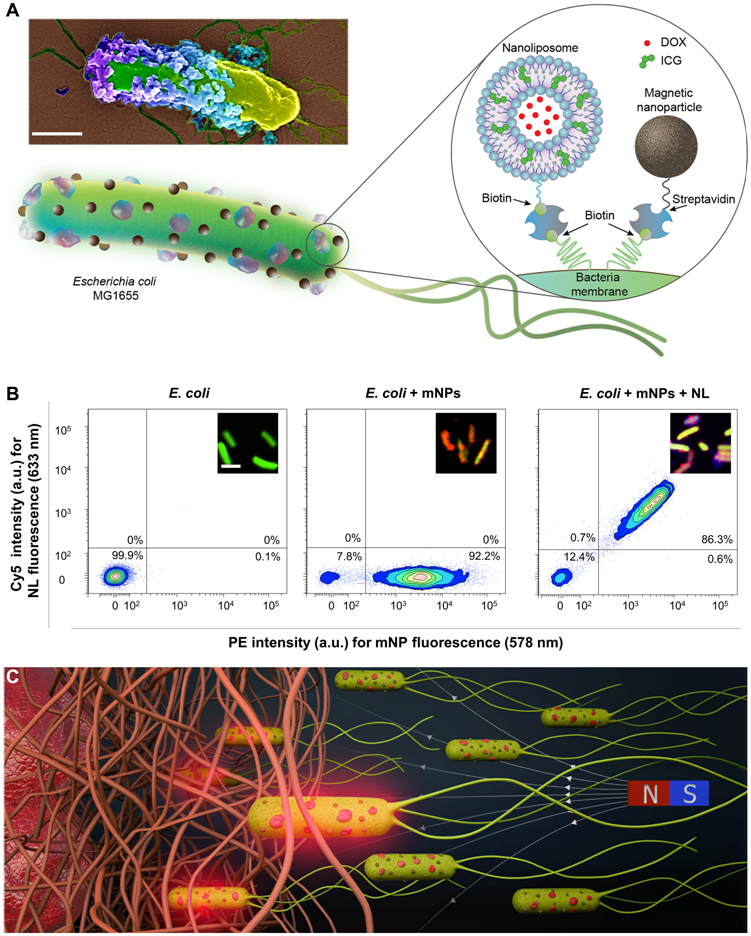
In a new study, researchers from the Max Planck Institute for Intelligent Systems in Germany combined robotics with biology, equipping Escherichia coli with artificial components to construct biohybrid microrobots. First, they attached several nanoliposomes to each E. coli, which encapsulated indocyanine green (ICG) that melts when exposed to near-infrared light. Moving inward, these nanoliposomes contain the water-soluble chemotherapy drug doxorubicin (DOX) within their aqueous core.
Related research results were published in the July 15, 2022, issue of Science Advances, titled “Magnetically steerable bacterial microrobots moving in 3D biological matrices for stimuli-responsive cargo delivery.”

The second component attached to the E. coli is magnetic nanoparticles: iron oxide particles. When exposed to a magnetic field, these iron oxide particles act as a top booster for these highly mobile microorganisms. This design allows for easier control of E. coli swimming—an improvement for in vivo applications. Meanwhile, a very stable and hard-to-destroy streptavidin-biotin complex binds these nanoliposomes and magnetic particles to the E. coli, which has been useful in constructing biohybrid microrobots (Scientific Reports, 2018, doi:10.1038/s41598-018-28102-9).
E. coli is a fast and versatile “swimmer” capable of navigating through materials ranging from liquids to highly viscous tissues. But that’s not all; they also have highly advanced sensing capabilities. Bacteria are attracted to chemical gradients, such as low oxygen levels or high acidity—both of which are commonly found near tumor tissues. The treatment of cancer by injecting bacteria near tumors is known as bacterial-mediated tumor therapy. The bacteria flow toward the tumor, grow there, and activate the patient’s immune system in this way. For over a century, bacterial-mediated tumor therapy has been a treatment method.
In recent decades, scientists have been searching for ways to further enhance these superpowers of bacteria. They have equipped bacteria with additional components to help them fight. However, adding artificial components is not an easy task. Complex chemical reactions are at play, and the density of particles loaded onto the bacteria is crucial to avoid dilution. In this new study, the authors have significantly raised the bar. They managed to equip 86 out of 100 bacteria with nanoliposomes and magnetic nanoparticles.
The authors demonstrated how they successfully guided such a high-density bacterial solution externally through different routes. First, through an L-shaped narrow channel, with two compartments at each end, each containing a tumor spheroid. Second, a narrower setup resembling small blood vessels. They added an extra permanent magnet on one side and showed how they could precisely control the drug-loaded microrobots toward the tumor spheroid. Third, they guided the microrobots through viscous collagen gels (similar to tumor tissues) with three levels of hardness and porosity. The harder the collagen, the tighter the mesh of the collagen gel, making it harder for the bacteria to find a path through the matrix. They found that once they added a magnetic field, the bacteria managed to navigate all the way to the other end of the collagen gel. Through continuous alignment, the bacteria found a way to traverse the collagen gel.
Once these microrobots accumulate at the desired site (tumor spheroid), a near-infrared laser generates rays with temperatures up to 55 degrees Celsius, triggering the melting process of the nanoliposomes and releasing the contained drugs. Low pH or acidic environments can also cause the nanoliposomes to burst, allowing the drugs to be released automatically near the tumor.

Biohybrid microrobots carrying magnetic nanoparticles and nanoliposomes. Image from Science Advances, 2022, doi:10.1126/sciadv.abo6163.
Mukrime Birgül Akolpoglu, co-first author of the paper and a PhD student at the Max Planck Institute for Intelligent Systems, said, “Imagine, we will inject this bacterial-based microrobot into cancer patients. With a magnet, we can precisely direct them toward the tumor. Once enough microrobots surround the tumor, we will aim the laser at the tumor tissue and trigger the release of the drug. Today, not only is the immune system triggered awake, but the released drugs also help destroy the tumor.”
Dr. Yunus Alapan, co-first author of the paper and a former postdoctoral researcher at the Max Planck Institute for Intelligent Systems, added, “This on-site drug delivery will be minimally invasive, painless, and with minimal toxicity, allowing the drug to act where it is needed, rather than throughout the whole body.”
Dr. Metin Sitti, corresponding author and head of the Physical Intelligence Department at the Max Planck Institute for Intelligent Systems, said, “Bacterial-based biohybrid microrobots with medical functions may one day fight cancer more effectively. This is a new treatment method that is quite different from our current ways of treating cancer. The therapeutic effects of medical microrobots in seeking and destroying tumor cells could be enormous. Our research is a great example of fundamental research aimed at benefiting our society.”
References:
Mukrime Birgül Akolpoglu et al. Magnetically steerable bacterial microrobots moving in 3D biological matrices for stimuli-responsive cargo delivery. Science Advances, 2022, doi:10.1126/sciadv.abo6163.